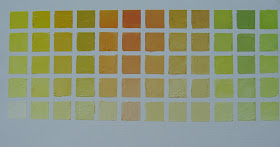If you've been following my blog the past few weeks, you know I've been spending time this summer to hunkering down and doing the comprehensive color studies recommended by Richard Schmid, in his excellent book "Alla Prima" He did them over 40 years ago and feels they are invaluable learning tools.
I had always wanted to do them "someday", but the task seemed daunting. But while I had some time off this summer from teaching my regular painting classes, I commited to completing them. I took it on as my own "Independent Study Color Intensive" to understand color mixing at a deeper and more "hands on" level than just knowledge about color theory.
I embarked on this with a little trepidation since it was a big undertaking, but I concentrated my efforts and completed the basic 13 charts and a couple of others I came up with which I thought would be helpful to adds ( i.e. neutrals and greens) in just one week.
In the archives of this blog for July 2011 ( listed in the right column) you can find past posts describing the process, how to get started, materials needed and my observations from each of the individual charts, but taken in total, there were some general learning that were also worthwhile.
Here are the top 10:
10) I overcame my fear of white. Being trained initially as a watercolorist I never had to use white till I started painting in oils. I considered it a "necessary evil" that's only purpose was to lighten a color. I tried to avoid white at all costs as some of my initial attempts at using it ended up chalky. Thru these charts, I quickly learned that some color combinations ( especially transparents) need some white to give them body, covering power and make the color apparent. Also white actually alters the color and temperature ( cools) so it transforms colors, beyond merely lightening them. After mixing close to 1000 swatches including white, I not only feel a lot more confident about using white, but see how vital white is. It really can create some wonderful nuanced tints of colors- which are especially evident in the bottom row of each chart( the one mixed with the most white)
9) I saw how harmonious each chart was since all 60 swatches on that page included some of the main color. Might be something to integrate more in my color choices in future paintings.
8) Gained speed in mixing colors and wielding a palette knife- Also appreciate how clean colors stay when mixing with the knife. I typically switch between mixing with a brush or knife( depending on what I have in my hand or if I remembered to even take my knife out) , but I plan to use the knife more consciously and consistently. Also came up with a handy approach to use 2 knifes- one for color and one for white to keep my pile of white paint totally unadulterated and pure.
7) Gained a greater ability to control value changes by having to mix multiple values of the same colors.
6) Gained a greater appreciation for the beauty of neutralized colors, especially the very high key tints.
5) It was very evident that color reads the strongest in the middle value range and most of the lightest lights looked very similar- in other words the hue distinctions were not as apparent in the lightest lights.
4) It doesn't take much to add a hint of color to white- so when going for the highest keys, start with white and add a touch till I get to the desired value and color.
3) Opaques tend to swallow up transparents
2) You really can mix most of the colors you buy from a few of the basics- over time I plan to cull down my supply of paint tubes . If I run out of something like Yellow Ochre, I can mix a close substitute. Also discovered many color combinations that were beautiful that I would never have thought of mixing together- like Viridian and Magenta and White.
And the #1 thing I learned from the color studies...
1 ) There are truly endless color possibilities in each tube of paint!
I can't deny it was a lot of work, but it was fun as a sense of discovery and wonder would build, especially with combinations I was not as familiar with. "I wonder how this mixture will look?"
I now have the best reference book on color- once I created and experienced first hand. Last night I cleared a space in my studio to keep the book of colors out and available for use during painting sessions.
Now back to painting to apply what I've learned.




























